KOREAN TAKEOVER – HYUNDAI’S TCR CAR
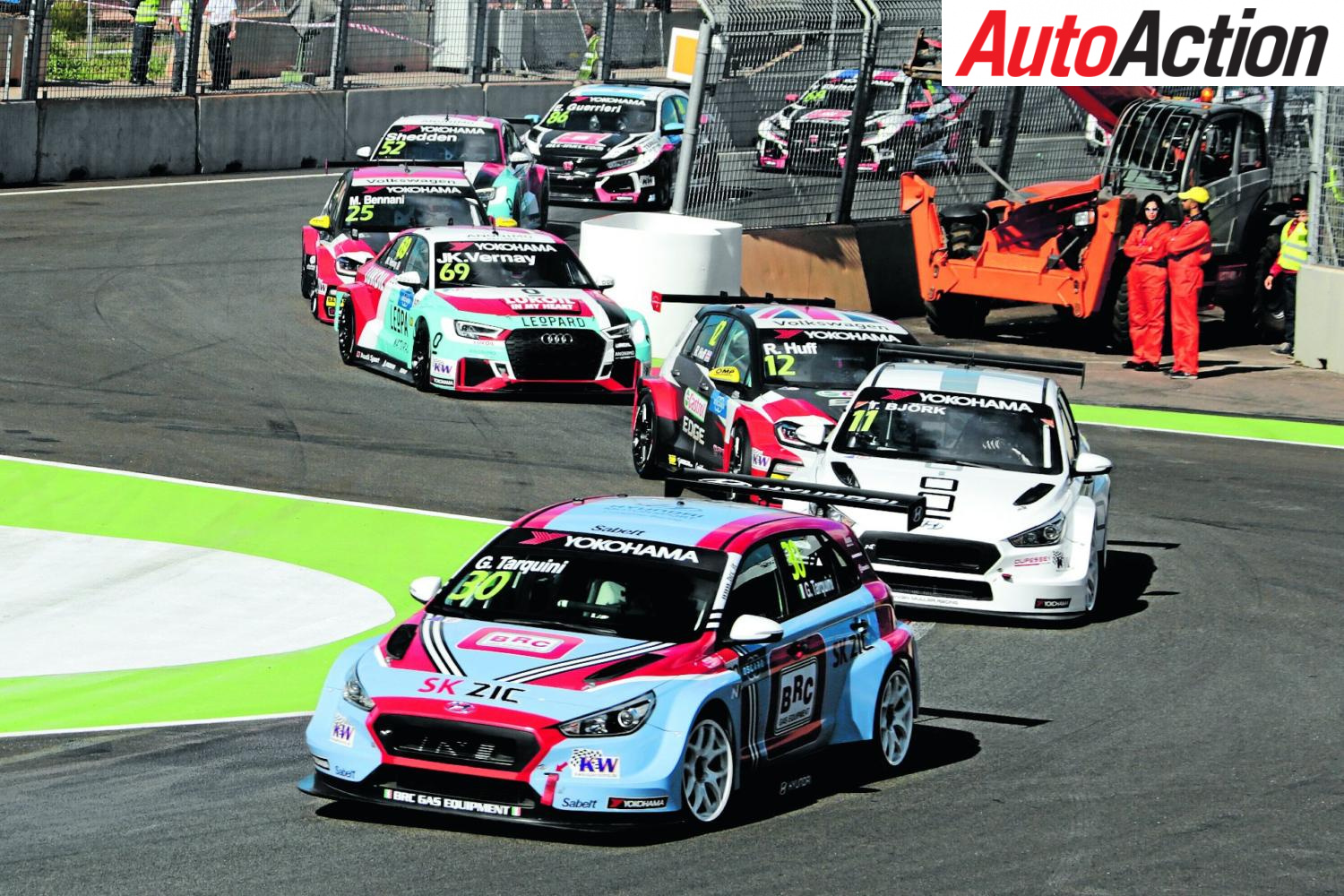
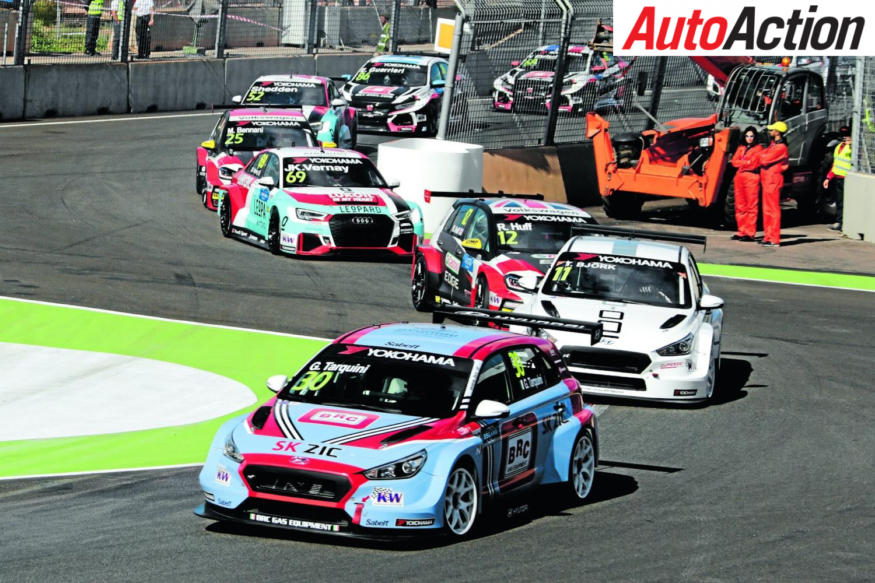
Touring car’s version of GT3, TCR has become the fastest growing motorsport formula in the world. With its tight rules set and by moving into new markets including America and Asia, TCR is generating high interest amongst the world’s manufacturers. Hyundai is taking TCR very seriously and is now using it to help grow its performance N nameplate
THE RAPID growth of TCR is rather astounding considering plans for the new touring car formula only began in 2014 and the first race run just a year later.
By HEATH MCALPINE
TCR is the brainchild of Italian promoter Marcello Lotti, who resurrected the World Touring Car Championship in 2005, but acrimoniously split with the WTCC’s management at the start of the 2014 season just when the series was preparing to move into its poorly received TC1 regulations.
As a consequence, Lotti formulated his own plans for a new touring car category using Stephane Ratel’s successful GT3 formula as inspiration.
The class had to be customer-based with the cars much like their showroom counterparts.
TCR is open to C-segment cars, with 2-litre turbocharged engines and must be front-wheel-drive.
Much like the Porsche GT3 Cup Car had done for GT3 10 years earlier, Seat’s Leon Supercopa provide the base for the new class.

It takes two weeks for the team at Hyundai Motorsport in Alzeau to build a new i30N TCR.
TCR’s first race was held at Sepang in March 2015, and while the field was mainly made up of Seats, there were a number of JAS Motorsport-developed Honda Civics, a pair of Opel Astra OPCs derived from a German one-make series, and a Ford Focus built and designed by Mike Earle of Onyx F1 fame.
Seat dominated the weekend but, more importantly, TCR was born.
Since then, the category has continued to buck the trend of manufacturers shying away from motorsport with the four original brands being joined by Volkswagen, Audi, Lada, Peugeot, Lada, in addition to the privateer efforts representing Subaru, Alfa Romeo, Kia and Renault.
Audi has used TCR as an extension of its highly-successful Customer Racing Program, and now Hyundai is intent on taking the battle right up to the Germans.
Hyundai announced its TCR plans in February 2017, with work having started five months earlier, shortly after the new i30 was revealed and plans were hatched to launch the Korean manufacturer’s new performance sub-brand, N.
In what would become a co-current programme with the New Generation i20 R5 rally car, the i30N TCR was the perfect way to promote the brand through motorsport, joining its WRC campaign.
“The beginning of our first project specifically for circuit racing is a very important step for Hyundai Motorsport,” team principal Michel Nandan said.

This has been touring car legend Gabriele Tarquini’s office for the past year during a significant development programme.
“TCR regulations have proven to be incredibly successful and are being embraced around the world. By representing Hyundai in the various championships, our TCR car will promote the manufacturer in motorsport, together with our WRC and R5 projects.”
Around 10 per cent of components are shared between the road and race cars, but the Hyundai Motorsport-developed 2-litre turbocharged race motor punches out 260kw at 7000rpm compared to the ‘standard’ 202kw/6000rpm road-going version.
The engine location can’t be changed, while mechanical modifications are limited to replacing the cylinder head gasket and crankshaft bearings with stronger products of the exact same dimensions, the intercooler (though Hyundai Motorsport continue to use the road car version) and injectors, with the biggest gains made by the BMC air induction kit and Life Racing ECU and data logger.
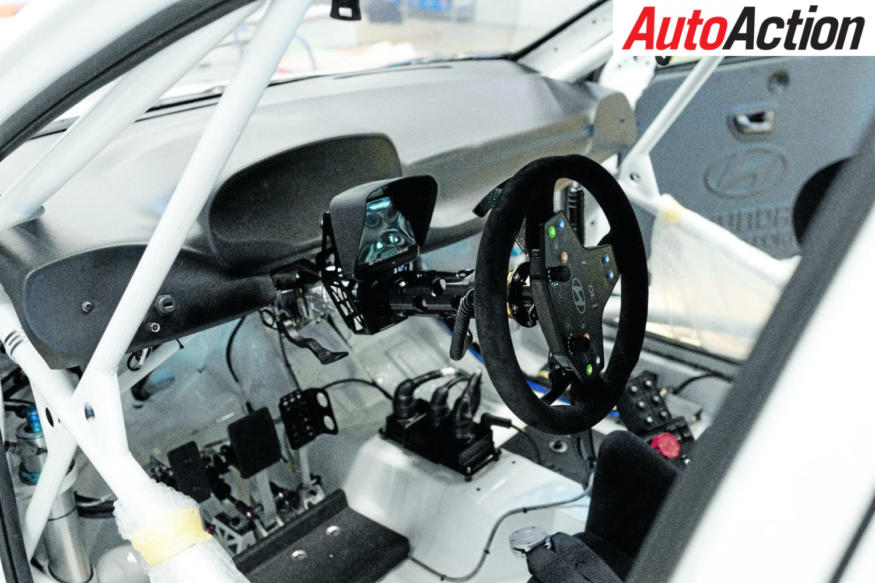
Life Racing provide the instrument column and Sabelt provide the steering, wheel, harness and racing seat, left.
TCR officials heavily police the ECU with manufacturers required to seal each unit. /Software and mapping is frozen unless changes are approved by the series.
In addition, manufacturers must also provide the ECU interface cable along with the software and datasets in a binary format free of charge.
Rules do permit a racing sequential gearbox, with Hyundai Motorsport having installed a 6-speed Xtrac unit that uses a pneumatic paddle shift.
Power is sent to the front drive wheels through an AP Racing Ceremetallic twin-disc clutch and mechanical differential with external preload adjustment.
Stopping power is provided by a bespoke Brembo kit consisting of 6-piston monobloc calipers with 380mm diameter ventilated brake discs at the front, and 2-piston monobloc calipers with 278mm diameter ventilated brake discs at the rear.
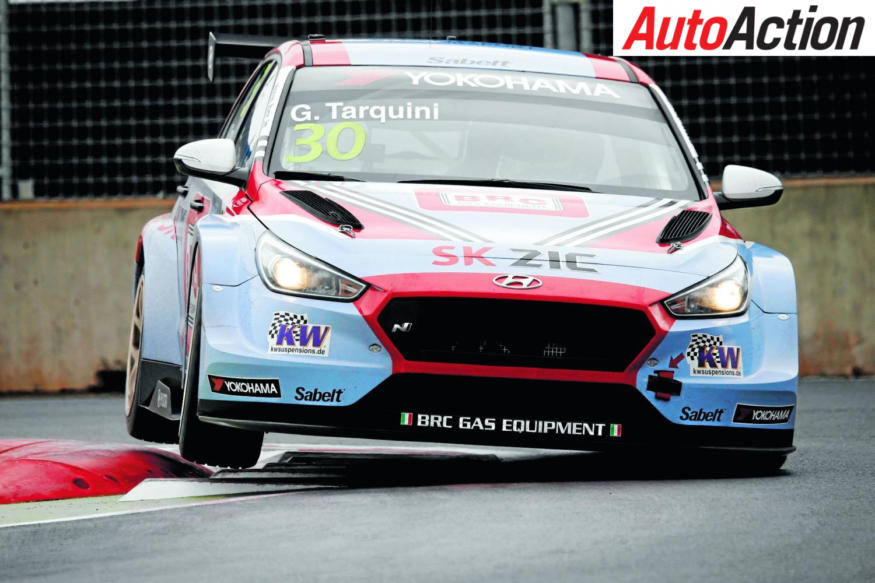
Hyundai kicked off its WTCR program in style, Tarquini winning the very first race in his i30 N TCR. of Morocco at Marrakech, from April 7 to 8th – Photo Paulo Maria / DPPI
Goodridge provides the hoses and fittings that make up the plumbing within the brake system, while the driver has an adjustable pedal in the pedal box and there are spherical bearing-mounted Brembo master cylinders.
Driver aids such as ABS, Electronic Stability Program, and Traction Control are not permitted, meaning the suspension has an increased role when it comes to handling and set-up.
Up front, MacPherson struts do all the work, while the 4-arm multi-link suspension continues the connection between the road and the race car as both share the same set-up.
As defined by the regulations, two-way adjustable shock absorbers are on all four corners.
Hyundai Motorsport’s factory in Alzenau, Germany is where the build of the i30N TCR takes place.

Engine development is limited in TCR competition, but the 2-litre turbocharged engine still makes 260kw – a considerable jump over the road-going version. Photo: TCR Media
The design of the roll cage provides a significant safety cell within the car using high-tensile, lightweight steel, taking into consideration what the team has learnt from the WRC.
The shell is straight off the production line but has the standard deletions including sound proofing and most of the interior, except for the dash.
Composite materials are permitted to replace the standard door trims, but the production door locks, intrusion bars, and the driver side window switch have to remain.
Hyundai Motorsport changes the instruments to Life Racing units.
TCR’s category data logging is key to the closeness of the competition with series officials tracking items such as engine revs, timing, engine water temperature, inlet manifold air temperature and boost pressure, in addition to GPS.

The bodyshell is straight from the Hyundai production line and on arrival receives further strengthening to withstand the rigours of racing.
This data can’t be viewed by teams, but another removable memory device is used as a separate way to collate information and it must still must be made available to TCR officials at all times. Telemetry is not permitted.
A Sabelt racing seat, HANS compatible 6-point harness, and a 330mm flat steering wheel welcome the driver into the cockpit.
A Lifeline fire extinguisher system using a 3M Novec 1230 clean agent – a non-toxic, non-carcinogenic, and non-ozone depleting agent – is also used, with only 1.5kg of the agent required to pass the FIA fire test, reducing the overall size and weight of the fire system.
An added safety feature is the roof hatch, with hatches becoming more prevalent on racing cars in the safety-focussed modern era to allow rescue crews to easily access the driver after an incident.
Limited modifications continue on the outside with the bonnet and boot coming directly off the road car.
The major difference is the stance of the i30N TCR is wider to allowed 18×10 Braid custom rims and WTCR control Yokohama Advan A005 250/660R18 to be fitted.
The front and rear bumpers are composite and must still resemble the road-going counterparts, while dive planes are banned.

Brembo supply the brakes for the Hyundai. Photos: Hyundai Motorsport
The front splitter and rear wing are standard across all TCR cars, while the rear door can be modified to meet the now-widened rear flares.
A main feature of the former WTCC S2000 tourers was a flat floor beyond the front wheels, but that is banned in TCR.
Air jacks are permitted with the bodywork modified slightly to allow them, and instead of putting fuel in the filler compartment, the compressed air connector neatly replaces it.
In all, a new i30N TCR can be built within two weeks by the crew at Hyundai Motorsport.
Hyundai Motorsport undertook an exhaustive testing programme with the new car, with its first appearance at the Spanish Motorland Aragon circuit with ex-Formula 1 driver and multiple touring car champion, Gabriele Tarquini behind the wheel.
The three-day test was important to gauge the certain characteristics of the new i30N TCR, and test its reliability while being Tarquini’s first run in any sort of TCR machinery, it was vital there were no issues.
Not only did the Hyundai prove fast and reliable, but Tarquini and Hyundai Motorsport’s strong contingent of engineers were able devise strong base set-ups for the car thanks to the circuit layout providing with the perfect variety of track situations.
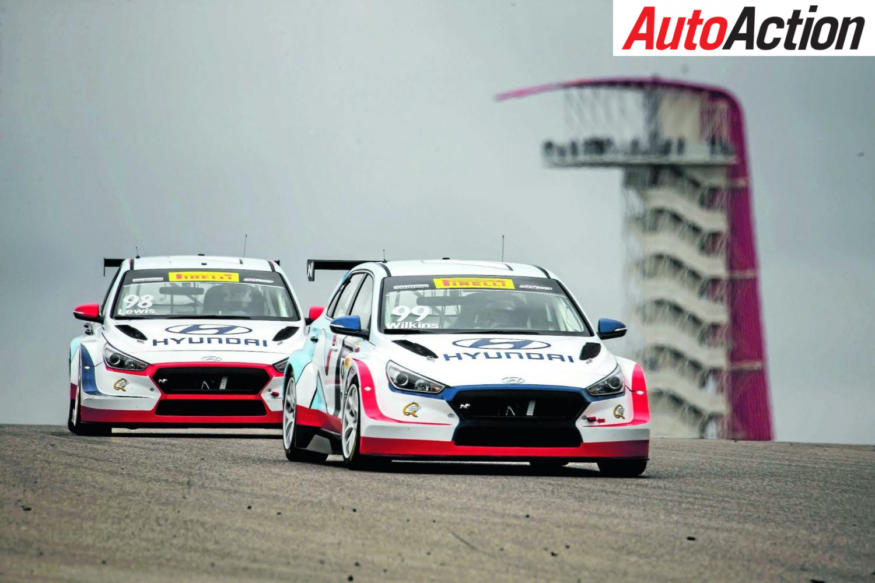
Not only has the Hyundai had success on the European stage, but Bryan Herta Autosports in the US has also tasted victory.
“The first test of a new car is always a very exciting moment in a project,” Hyundai Motorsport customer racing development manager Andrea Adamo said.
“To come through three days without a major problem made it even better. We were able to complete all the work we had set out for the test, which is obviously a nice start to a busy development schedule for the New Generation i30 TCR project.
“We were also able to work on the balance of the car and start developing an initial set-up that we can use in future, not only for the handling, but the important engine and differential settings. We now use these as a base while turning our focus to gaining maximum performance from specific components.”
Further development continued at Misano in Italy and Valencia in Spain where the team worked on improving the brake and damper set-ups, before announcing it would continue its development in a racing environment by entering the Misano 24 Hour.
The race was also the perfect opportunity to develop the endurance kit, which allows for ABS, a 100-litre fuel tank, and extra driving lights.
Misano was a great success, prompting Hyundai Motorsport to debut the car in the final two TCR International rounds at Zhejiang, China and Dubai late last year.
Tarquini and teammate Alain Menu showed the pace of the i30N against its TCR counterparts by being 0.5s faster in qualifying with Tarquini winning on its debut in China.
“We hit all the targets that we set for the i30 N TCR. We went to China to show the competitiveness of the car against the others in the TCR International Series,” Adamo said.
“Our performance and reliability showed that the i30 N TCR is strong not only on fast, flowing tracks, but also on tighter, more technical layout.
“Our customers should be able to take their new car to any circuit, in any series and be able to fight at the front.”
Tarquini said the Hyundai’s TCR debut was almost perfect and demonstrated Hyundai Motorsport had developed a competitive package for the category.
“We showed we have developed a very strong car for the TCR regulations. We did not expect to be able to fight for the victory on debut, especially on such a tough circuit, but I was able to take advantage of the good brakes and handling of the car to make the most of the pace of the i30 N TCR.”
Prior to the recent opening of the 2018 WTCR season, all models that participate in international TCR competition took part in a Balance of Performance test in Valencia.
As a result, adjustments were made to the weight and ride height of each car to create a competitive environment for each manufacturer.
As this was happening, Hyundai Motorsport was handing over its first customer cars to Italy’s BRC Racing Team and the South Korean KMSA squad.
Further cars have since been purchased by Bryan Herta Autosport in the US, and Yvan Muller for his two-car attack on the WTCR.
“The first deliveries of i30 N TCR to customers was obviously a major step in this very important project,” Adamo said.
“It marked the end of a busy period of development running at circuits and events around the world for the team.”
With TCR on the horizon for Australia, it provides a viable option to Supercars for manufacturers to compete in.
Will Hyundai lead the charge?
ELECTRIC DREAMS
PLANS ARE well advanced for an all-electric touring car series using the successful TCR formula.
WSC Technology, a subsidiary of the WSC Group that developed TCR, displayed a Seat Cupra e-Racer at the Geneva Motor Show last month, right.
The concept calls for teams to run E TCR branded power units, gearboxes, inverters and a promoter supplied battery pack.
Power is set to come from an electric motor, with power estimates stated at 300kw of continuous power and 500kw at 12,000rpm when at max power.
Drive will be through a single gear at the rear wheels, while the battery capacity is 65kWh 800V.
“Why E TCR?” Marcello Lotti asked at the launch.
“Because our group feels to have a sense of responsibility towards the whole touring car racing scene and so, consequently, could not ignore the trends of developing new technologies.
“We will be working on the same technical principles that made TCR so successful, with the aim of creating a platform for this new configuration.”

SPECS: HYUNDAI i30N TCR
Engine
Type: Hyundai Motorsport 2.0 litre
direct injection, turbocharged
Power (Max): 350hp @ 7000 rpm
Torque (Max): 450Nm @3500 rpm
Electronics: Life Racing ECU and power
management system
Transmission
Type: Front-wheel drive
Gearbox: Six-speed sequential gearbox with pneumatic paddle-shift
Differential: Mechanical with external pre-load adjuster
Clutch: AP Racing Ceremetallic twin-disc
Cockpit
Seats: Sabelt competition seats
Belts: Sabelt six-point HANS compatible
Dashboard: Life Racing compact configurable driver’s display
Chassis
Front suspension: MacPherson struts with adjustable dampers
Rear suspension: Four-arm multi-link with adjustable dampers
Steering: Hydraulic power-assisted rack and pinion
Front Brakes: 380mm ventilated brake discs with Hyundai Motorsport
branded six-piston Brembo calipers
Rear Brakes: 278mm brake discs with two- piston calipers
Handbrake: Hydraulic control
Wheels: 10×18 inch aerodynamic Braid rims, designed specifically
for Hyundai Motorsport
Bodywork
Structure: Hyundai Motorsport designed lightweight high-tensile
steel roll cage
Bodywork: Steel and composite fibre panels
Length: 4450mm
Wheelbase: 2650mm
Width: 1950mm
Track Width: 1610mm
Fuel Tank Capacity: 100 litres
Weight: 1285kg minimum
(including driver)*
For Auto Action’s latest feature, pick up the latest issue of the magazine, on sale now. Also make sure you follow us on social media Facebook, Twitter, Instagram or our weekly email newsletter for all the latest updates between issues.


